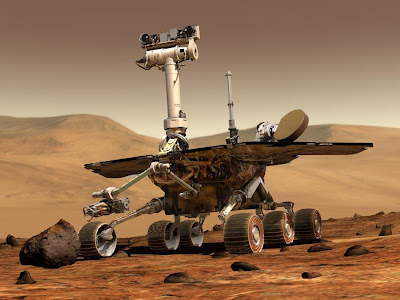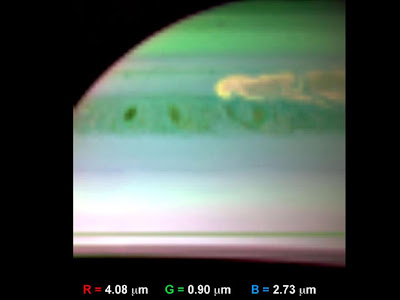NASA's Hubble Space Telescope has found a rare class of oddball stars called blue stragglers in the hub of our Milky Way, the first detected within our galaxy's bulge.
Blue stragglers are so named because they seemingly lag behind in the aging process, appearing younger than the population from which they formed. While they have been detected in many distant star clusters, and among nearby stars, they never have been seen inside the core of our galaxy.
It is not clear how blue stragglers form. A common theory is that they emerge from binary pairs. As the more massive star evolves and expands, the smaller star gains material from its companion. This stirs up hydrogen fuel and causes the growing star to undergo nuclear fusion at a faster rate. It burns hotter and bluer, like a massive young star. The findings support the idea that the Milky Way's central bulge stopped making stars billions of years ago. It now is home to aging sun-like stars and cooler red dwarfs. Giant blue stars that once lived there have long since exploded as supernovae.
The findings support the idea that the Milky Way's central bulge stopped making stars billions of years ago. It now is home to aging sun-like stars and cooler red dwarfs. Giant blue stars that once lived there have long since exploded as supernovae.
The results have been accepted for publication in an upcoming issue of The Astrophysical Journal. Lead author Will Clarkson of Indiana University in Bloomington, will discuss them today at the American Astronomical Society meeting in Boston.
"Although the Milky Way bulge is by far the closest galaxy bulge, several key aspects of its formation and subsequent evolution remain poorly understood," Clarkson said. "Many details of its star-formation history remain controversial. The extent of the blue straggler population detected provides two new constraints for models of the star-formation history of the bulge."
The discovery followed a seven-day survey in 2006 called the Sagittarius Window Eclipsing Extrasolar Planet Search (SWEEPS). Hubble peered at 180,000 stars in the crowded central bulge of our galaxy, 26,000 light-years away. The survey was intended to find hot Jupiter-class planets that orbit very close to their stars. In doing so, the SWEEPS team also uncovered 42 oddball blue stars with brightness and temperatures typical for stars much younger than ordinary bulge stars.
The observations clearly indicate that if there is a young star population in the bulge, it is very small. It was not detected in the SWEEPS program. Blue stragglers long have been suspected to be living in the bulge, but had not been observed because younger stars in the disk of our galaxy lie along the line-of-sight to the core, confusing and contaminating the view.
Astronomers used Hubble to distinguish the motion of the core population from foreground stars in the Milky Way. Bulge stars orbit the galactic center at a different speed than foreground stars. Plotting their motion required returning to the SWEEPS target region with Hubble two years after the first observations were made. The blue stragglers were identified as moving along with the other stars in the bulge.
"The size of the field of view on the sky is roughly that of the thickness of a human fingernail held at arm's length, and within this region, Hubble sees about a quarter million stars toward the bulge," Clarkson said. "Only the superb image quality and stability of Hubble allowed us to make this measurement in such a crowded field."
From the 42 candidate blue stragglers, the investigators estimate 18 to 37 are likely genuine. The remainder could be a mix of foreground objects and, at most, a small population of genuinely young bulge stars.
"The SWEEPS program was designed to detect transiting planets through small light variations" said Kailash Sahu, the principal investigator of the SWEEPS program. "Therefore the program could easily detect the variability of binary pairs, which was crucial in confirming these are indeed blue stragglers."
Hubble is a project of international cooperation between NASA and the European Space Agency. NASA's Goddard Space Flight Center in Greenbelt, Md., manages the telescope. The Space Telescope Science Institute (STScI) conducts Hubble science operations. STScI is operated for NASA by the Association of Universities for Research in Astronomy in Washington.
NASA's Hubble Finds Rare 'Blue Straggler' Stars in Milky Way's Hub
NASA Concludes Attempts to Contact Mars Rover Spirit
NASA is ending attempts to regain contact with the long-lived Mars Exploration Rover Spirit, which last communicated on March 22, 2010.
A transmission that will end on Wednesday, May 25, will be the last in a series of attempts. Extensive communications activities during the past 10 months also have explored the possibility that Spirit might reawaken as the solar energy available to it increased after a stressful Martian winter without much sunlight. With inadequate energy to run its survival heaters, the rover likely experienced colder internal temperatures last year than in any of its prior six years on Mars. Many critical components and connections would have been susceptible to damage from the cold. Engineers' assessments in recent months have shown a very low probability for recovering communications with Spirit. Communications assets that have been used by the Spirit mission in the past, including NASA's Deep Space Network of antennas on Earth, plus two NASA Mars orbiters that can relay communications, now are needed to prepare for NASA's Mars Science Laboratory mission. MSL is scheduled to launch later this year.
Engineers' assessments in recent months have shown a very low probability for recovering communications with Spirit. Communications assets that have been used by the Spirit mission in the past, including NASA's Deep Space Network of antennas on Earth, plus two NASA Mars orbiters that can relay communications, now are needed to prepare for NASA's Mars Science Laboratory mission. MSL is scheduled to launch later this year.
"We're now transitioning assets to support the November launch of our next generation Mars rover, Curiosity," said Dave Lavery, NASA’s program executive for solar system exploration. "However, while we no longer believe there is a realistic probability of hearing from Spirit, the Deep Space Network may occasionally listen for any faint signals when the schedule permits."
Spirit landed on Mars on Jan. 3, 2004, for a mission designed to last three months. After accomplishing its prime-mission goals, Spirit worked to accomplish additional objectives. Its twin, Opportunity, continues active exploration of Mars.
Cassini and Telescope See Violent Saturn Storm
NASA's Cassini spacecraft and a European Southern Observatory ground-based telescope tracked the growth of a giant early-spring storm in Saturn's northern hemisphere that is so powerful it stretches around the entire planet. The rare storm has been wreaking havoc for months and shooting plumes of gas high into the planet's atmosphere. Cassini's radio and plasma wave science instrument first detected the large disturbance, and amateur astronomers tracked its emergence in December 2010. As it rapidly expanded, its core developed into a giant, powerful thunderstorm. The storm produced a 3,000-mile-wide (5,000-kilometer-wide) dark vortex, possibly similar to Jupiter's Great Red Spot, within the turbulent atmosphere.
Cassini's radio and plasma wave science instrument first detected the large disturbance, and amateur astronomers tracked its emergence in December 2010. As it rapidly expanded, its core developed into a giant, powerful thunderstorm. The storm produced a 3,000-mile-wide (5,000-kilometer-wide) dark vortex, possibly similar to Jupiter's Great Red Spot, within the turbulent atmosphere.
The dramatic effects of the deep plumes disturbed areas high up in Saturn's usually stable stratosphere, generating regions of warm air that shone like bright "beacons" in the infrared. Details are published in this week's edition of Science Magazine.
"Nothing on Earth comes close to this powerful storm," says Leigh Fletcher, the study's lead author and a Cassini team scientist at the University of Oxford in the United Kingdom. "A storm like this is rare. This is only the sixth one to be recorded since 1876, and the last was way back in 1990."
This is the first major storm on Saturn observed by an orbiting spacecraft and studied at thermal infrared wavelengths, where Saturn's heat energy reveals atmospheric temperatures, winds and composition within the disturbance.
Temperature data were provided by the Very Large Telescope (VLT) on Cerro Paranal in Chile and Cassini's composite infrared spectrometer (CIRS), operated by NASA's Goddard Space Flight Center in Greenbelt, Md.
"Our new observations show that the storm had a major effect on the atmosphere, transporting energy and material over great distances, modifying the atmospheric winds -- creating meandering jet streams and forming giant vortices -- and disrupting Saturn's slow seasonal evolution," said Glenn Orton, a paper co-author, based at NASA's Jet Propulsion Laboratory in Pasadena, Calif. The violence of the storm -- the strongest disturbances ever detected in Saturn's stratosphere -- took researchers by surprise. What started as an ordinary disturbance deep in Saturn's atmosphere punched through the planet's serene cloud cover to roil the high layer known as the stratosphere.
The violence of the storm -- the strongest disturbances ever detected in Saturn's stratosphere -- took researchers by surprise. What started as an ordinary disturbance deep in Saturn's atmosphere punched through the planet's serene cloud cover to roil the high layer known as the stratosphere.
"On Earth, the lower stratosphere is where commercial airplanes generally fly to avoid storms which can cause turbulence," says Brigette Hesman, a scientist at the University of Maryland in College Park who works on the CIRS team at Goddard and is the second author on the paper. "If you were flying in an airplane on Saturn, this storm would reach so high up, it would probably be impossible to avoid it."
Other indications of the storm's strength are the changes in the composition of the atmosphere brought on by the mixing of air from different layers. CIRS found evidence of such changes by looking at the amounts of acetylene and phosphine, both considered to be tracers of atmospheric motion. A separate analysis using Cassini's visual and infrared mapping spectrometer, led by Kevin Baines of JPL, confirmed the storm is very violent, dredging up larger atmospheric particles and churning up ammonia from deep in the atmosphere in volumes several times larger than previous storms. Other Cassini scientists are studying the evolving storm, and a more extensive picture will emerge soon.
The Cassini-Huygens mission is a cooperative project of NASA, the European Space Agency and the Italian Space Agency. The mission is managed by JPL for NASA's Science Mission Directorate in Washington. The European Southern Observatory in Garching, Germany operates the VLT in Chile. JPL is a division of the California Institute of Technology in Pasadena.



